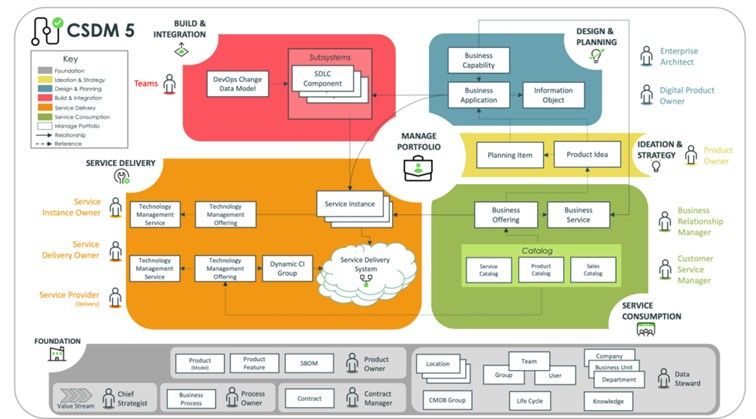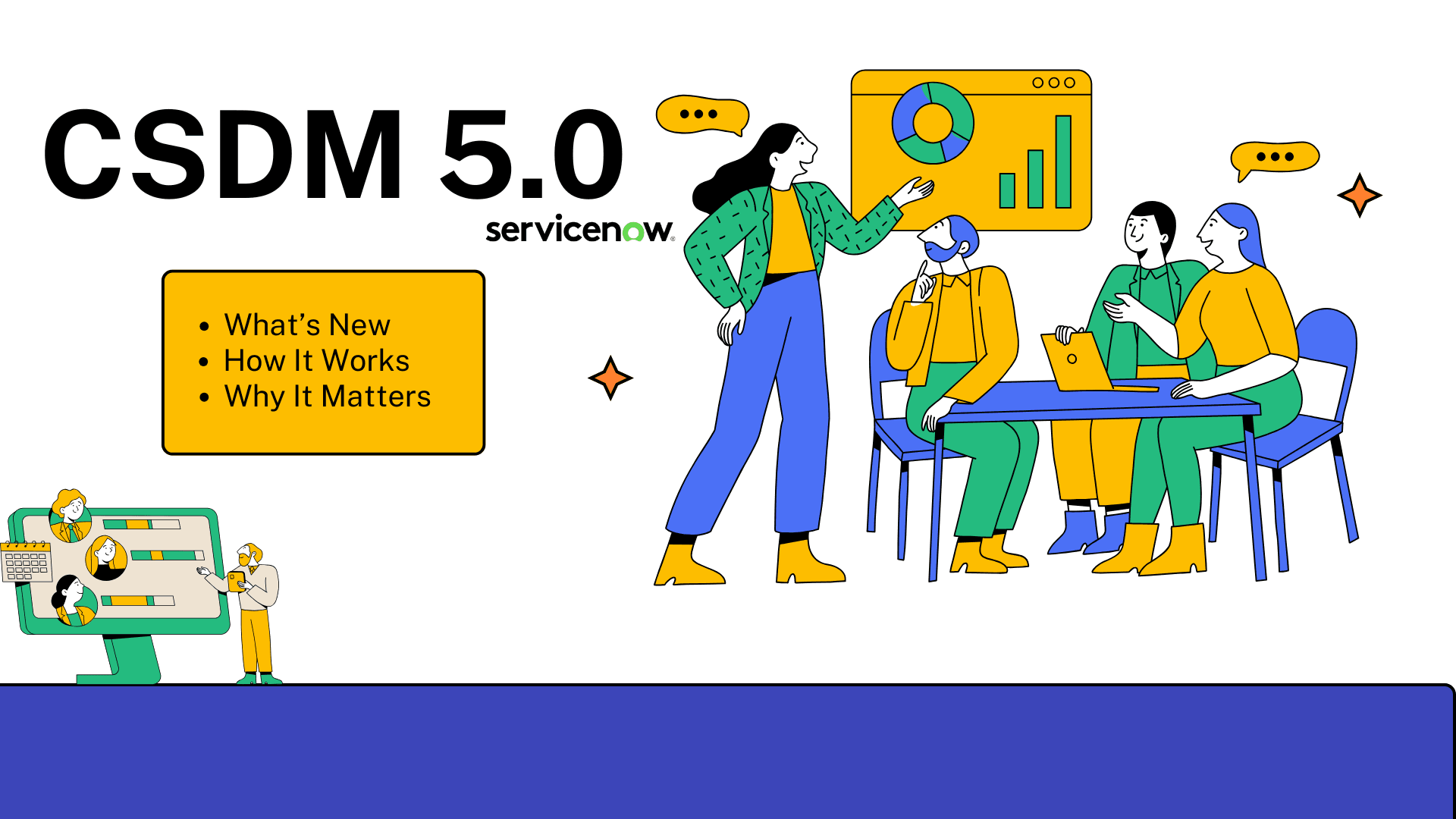In the evolving landscape of digital business transformation, a robust and standardized data model is crucial for success. ServiceNow's Common Service Data Model (CSDM) provides a foundational framework for managing services and data within the Configuration Management Database (CMDB). As organizations mature, so too does their need for a more comprehensive and forward-looking data model. Enter CSDM 5.0, an evolution designed to support sophisticated generative AI and enterprise-wide digital transformation.
At its core, CSDM is not a product or a module you purchase; rather, it's a standard, shared set of service-related definitions and a CMDB framework across ServiceNow products and the Now Platform. It offers prescriptive guidance on service modeling using out-of-box (OOB) tables and relationships, enabling true service-level reporting and supporting multiple configuration strategies. CSDM is foundational, meaning all core objects and CMDB tables are provided OOB regardless of licensing, and many ServiceNow products depend on the data within this model.
What's New in CSDM 5.0 Compared to CSDM 4.0?
CSDM 5.0 represents a significant evolution, building upon the efforts outlined in CSDM 4.0 and extending its scope to support broader digital transformation initiative. Here are the key differences and new additions:
1. Expanded Domain Structure:
- CSDM 4.0 operated with 5 domains: Foundation, Design, Build, Manage Technical Services, and Sell/Consume.
- CSDM 5.0 expands to 7 domains: Foundation, Ideation & Strategy (new), Design & Planning, Build & Integration, Service Delivery (renamed from Manage Technical Services), Service Consumption, and Manage Portfolios. The new "Ideation & Strategy" domain introduces concepts like Product Idea, Planning Item, Strategic Priority, Goal, and Target, aligning CSDM more closely with strategic planning. The "Manage Technical Services" domain has been relabeled to "Service Delivery".
2. Product Modeling Enhancements:
- CSDM 5.0 introduces expanded product modeling capabilities, including new product models such as the System Component Model, Software Component Model, Service Offering Model, and the Product Feature capability. These additions provide greater visibility into the development, release, deployment, and consumption of versioned products and components.
3. Introduction of Service Instances:
- CSDM 4.0 primarily focused on "Application Service" as a logical representation of a deployed system or application stack.
- CSDM 5.0 broadens this concept by relabeling cmdb_ci_service_auto to "Service Instance". "Application Service" now becomes a type of Service Instance. CSDM 5.0 introduces several new Service Instance siblings to accommodate expanded service use cases, including:
- Data and AI Service Instance
- Connection Service Instance
- Network Service Instance
- Operational Process Service Instance
- Facility Service Instance
4. Renamed Service Types:
- In CSDM 4.0, "Technical Service" was a core service type.
- In CSDM 5.0, "Technical Service" is relabeled to "Technology Management Service". Similarly, "Technical Service Offering" becomes "Technology Management Service Offering".
5. New Capabilities:
- Software Bill of Materials (SBOM): A new addition in CSDM 5.0, SBOM provides a detailed inventory of software components, critical for security operations and vulnerability tracking.
- Value Stream: Introduced as a new capability within the expanded Business Process model, defining how work delivers value across the organization.
- Teams: A related list for CIs in the CMDB, allowing flexible tracking of multiple user groups assigned to a CI.
- DevOps Change Data Model: Now available OOB via the App Store, supporting accelerated changes and transparent risk management.
- AI Data Model: New CI classes specifically for AI systems, including AI Function and AI Application, reflecting ServiceNow's focus on generative AI services.
- Operational Technology (OT): New classes added to support industrial environments and physical processes.
6. Broader Scope and Vision:
- CSDM 4.0 provided guidance on service-related definitions and modeling within the CMDB.
- CSDM 5.0 matures beyond a historical technology workflow focus to enable sophisticated generative AI and business transformation across a broad set of industry segments. It expands service management from technology services to industrial, operational, and utility services, connecting to various connected devices and products (IoT, medical, production, transportation, etc.).
How CSDM 5.0 Works: Core Concepts and Domains
CSDM 5.0 functions as a comprehensive data model with an end-to-end service lifecycle view, emphasizing how data flows through different stages and domains. The model is structured around seven domains, with "Foundation" serving as the underlying layer for all others. CSDM 5.0 is illustrated in Figure 1. Further details on the CSDM5.0 can be found in the white paper by Scott Lemm and Rob Koeten.

- Figure 1. CSDM 5 conceptual model.
- Foundation Domain: Contains base data referenced by other CSDM domains. These include organizational structures (Company, Business Unit, Department), Locations, Groups, Users, CMDB Group, Product Models, Business Process, Contracts, Value Streams, Product Features, and SBOM. The CSDM Life Cycle Stages and Statuses, a standardized way of tracking an object's status from inception to end-of-life, are also part of this domain.
- Ideation & Strategy Domain (New): The initial stage of the CSDM Life Cycle, focusing on new ideas, concepts, and strategic efforts for services. This includes Product Ideas, Planning Items (demands, projects, epics), Strategic Plans, Strategic Priorities, Goals, and Targets.
- Design & Planning Domain: Represents tables used by Enterprise Architecture (formerly Application Portfolio Management, APM) for logical design. Key entities include Business Capabilities (what the organization does, not how), Business Applications (logical representations of software and infrastructure), and Information Objects (describing types of data used, crucial for governance and compliance).
- Build & Integration Domain: Provides visibility into the build and integration efforts of digital products, often related to the DevOps process. This includes the DevOps Change Data Model, SDLC Components (representing unique development efforts like microservices), and AI Digital Assets (for AI/genAI services software components).
- Service Delivery Domain (Formerly Manage Technical Services): Represents the operational view of deployed service instances and the mechanisms needed to deliver services. This domain includes various Service Instances (Application, Data, Connection, Network, Operational Process, Facility), APIs, Applications (discoverable instances), AI Functions, AI Applications, Operational Technology (OT), Infrastructure CIs, Technology Management Services (formerly Technical Services), Technology Management Service Offerings, and Dynamic CI Groups. These are the "operational" tables used in ITSM processes like Incident, Problem, and Change.
- Service Consumption Domain: Identifies internal and external business services that may be impacted by items in the Service Delivery domain. This includes Business Services (published to business users), Business Service Offerings (stratification of a business service with commitments), Request Catalog, and Catalog Items (consumable representations of service offerings). These tables are also "operational" and selectable for ITSM.
- Manage Portfolio Domain: Encompasses portions of all other domains, providing service owners with oversight into business applications and their deployed instances (Application Services). This domain includes Portfolio and Service Portfolio concepts.
CSDM 5.0 also introduces the Digital System Model, a layered approach that breaks down the service model into Business Process, Service (Logical), Functional, and Infrastructure layers, providing clarity for operational control and lifecycle progression. Critical to the success of CSDM are its prescriptive relationships between Configuration Items (CIs), which are essential for functions like impact analysis in Incident and Change management.
Adopting CSDM is recommended in a staged manner: Foundation, Crawl, Walk, Run, Fly, allowing organizations to gradually implement the data model and realize value.
Why CSDM 5.0 Matters?
Following CSDM 5.0 offers significant value, solidifying ServiceNow as a foundation for digital transformation:
- Standardization and Common Language: CSDM provides a single, consistent data model across all ServiceNow products, helping different roles and teams speak a common language and avoid confusion over data sources.
- Reduced Technical Debt: By adhering to OOB standards, organizations can reduce the need for custom data models and the associated maintenance burden, freeing up resources and improving efficiency.
- Greater Out-of-Box Functionality: ServiceNow products are increasingly designed to leverage CSDM-aligned data. Following the model ensures you get the full value from current and future product functionalities.
- Future-Proofing: As ServiceNow continues to grow and introduce new features, CSDM will be the evolving data model that accommodates platform expansion, ensuring your data structure remains relevant.
- Enhanced Reporting and Analytics: CSDM is designed to support consistent analysis, enabling robust reporting and performance analytics across your services and IT operations.
- Improved Implementation Velocity: By aligning data to CSDM early, you lay a strong foundation that accelerates the implementation and value realization of various ServiceNow products, including Enterprise Architecture (EA), DevOps, Service Mapping, and Service Portfolio Management (SPM).
- Better Impact Assessment: For ITSM processes like Incident, Problem, and Change, CSDM's structured relationships allow for accurate impact assessment on business services and offerings.
- Comprehensive Digital Business Transformation: CSDM 5.0's expanded scope, including new domains like Ideation & Strategy and the integration of AI models and Operational Technology, positions it as the blueprint for orchestrating digital value networks across the entire enterprise, not just IT. It helps manage risks, ensure compliance, and gain deeper insights into your digital products and services.
In essence, CSDM 5.0, combined with the ServiceNow AI Platform, provides a standardized blueprint for automated and integrated digital value networks. This leads to full-value chain alignment, improved quality, transparency, better insights, automation, and reduced costs, serving as the ultimate foundation for your digital transformation journey.
Your Questions Answered
Question: How can DSS help with CSDM?
Answer: DSS provides expert consulting to help you assess, plan, and implement CSDM 5.0 aligned with ServiceNow best practices — ensuring your CMDB is scalable, future-proof, and service-aware.
Question: We don’t have time to overhaul our CMDB. Can DSS still help?
Answer: Absolutely. DSS follows the Crawl → Walk → Run → Fly model to implement CSDM incrementally. We focus on business value and achievable steps — not just theory or documentation.
Question: What business value will we gain from working with DSS on CSDM?
Answer: Faster ServiceNow deployments, improved data quality, automation readiness, simplified reporting, and better impact analysis for ITSM and Change. DSS ensures your CMDB becomes a real strategic asset — not a liability.
